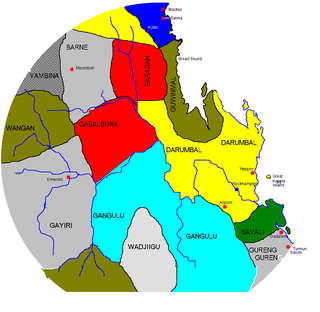
Ballardong are an indigenous Noongar people of the south western area of Western Australia.
The Wangan are an Aboriginal Australian people of the Isaac Region of Central Queensland.
The Tulua people were an Aboriginal Australian people of Queensland, in the southern to central region from the coast to the ranges. The Dappil and Tulua people possibly spoke the same language.
The Gia people, also known as Giya, Kia, Bumbarra, and variants, are an Aboriginal Australian people of the state of Queensland. Little is known of them.
The Maia were an indigenous Australian tribe of Western Australia.
The Wakabunga are an indigenous Australian people of the state of Queensland.
The Bidjara people, also spelt Bitjara or Bithara, are an Aboriginal Australian people of south-western Queensland. They spoke a dialect of the Ngura language. They are not to be confused with the Warrego River Pitjara or the Badjiri of the Paroo River, both of whose traditional lands are further to the east of the state.
The Marrago were an Aboriginal Australian people of the state of the Cape York Peninsula in northern Queensland. They may have been a subgroup of the Mayi-Kutuna.
The Miyan, or Mian, were an indigenous people of the state of Queensland.
The Wanamara (Wunumara) were an Aboriginal Australian people of the state of Queensland.
The Pitapita or Pitta Pitta are an Aboriginal Australian people of the state of Queensland.
The Ringaringa (Ringu-Ringu) were an indigenous Australian people of the state of Queensland.
The Rungarungawa were an Aboriginal Australian people of the state of Queensland.
The Yangga, also spelt Jangga, are an Aboriginal Australian people of the state of Queensland. They are not to be confused with the Yanga people.
The Yagalingu are an Aboriginal Australian people of the state of Queensland. Their language may have been a dialect of Bidjara.

The Yambina were an Aboriginal Australian people of the state of Queensland, whose traditional lands lie inland (westwards) some distance from Mackay.
The Kungadutji were an indigenous Australian people of the state of Queensland.
The Kunggara, also known as Kuritjara, are an indigenous Australian people of the southern Cape York Peninsula in Queensland.

The Bindal are the Aboriginal Australian people whose ancestors originally possessed, occupied, used and enjoyed approximately 2600 km2 of coastal country from the mouth of the Burdekin River north to Cape Cleveland, inland to Leichhardt Range, in the state of Queensland
The Waluwara were an indigenous Australian people of the state of Queensland.